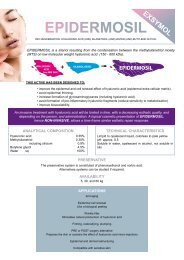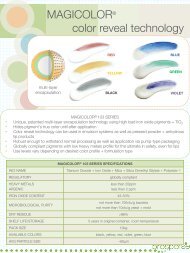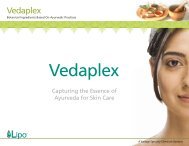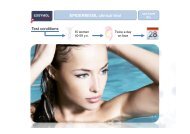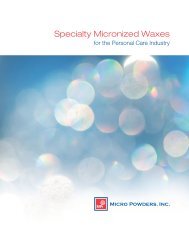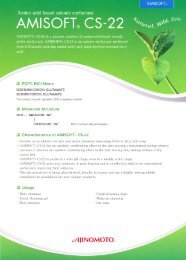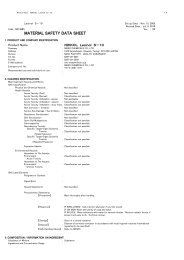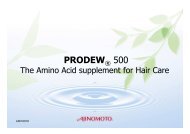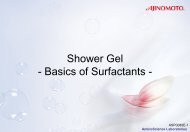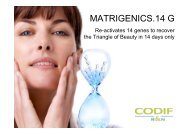Hydrogenated Soya Lecithin NIKKOL Lecinol S-10 - Cosmesi.it
Hydrogenated Soya Lecithin NIKKOL Lecinol S-10 - Cosmesi.it
Hydrogenated Soya Lecithin NIKKOL Lecinol S-10 - Cosmesi.it
Create successful ePaper yourself
Turn your PDF publications into a flip-book with our unique Google optimized e-Paper software.
<strong>Hydrogenated</strong> <strong>Soya</strong> <strong>Lec<strong>it</strong>hin</strong><br />
<strong>NIKKOL</strong> <strong>Lecinol</strong> S-<strong>10</strong><br />
R 1 COOCH 2<br />
|<br />
R 2 COOCH O R 1 ,R 2 : <strong>Hydrogenated</strong> Alkyl<br />
| ∥<br />
H 2 COPOX<br />
X : Phosphatidyl Choline<br />
|<br />
O -<br />
INCI name<br />
: HYDROGENATEDLECITHIN<br />
JCIC name<br />
: <strong>Hydrogenated</strong> Soybean Phospholipid<br />
CLS ingredient code : 42-506017<br />
CAS number : 92128-87-5<br />
EINECS number : 295-786-7<br />
<strong>Lec<strong>it</strong>hin</strong> is one of the most important components of a cell and plays an<br />
important role in <strong>it</strong>s metabolism, especially in <strong>it</strong>s const<strong>it</strong>ution and membrane<br />
penetrabil<strong>it</strong>y. For many years <strong>it</strong>s use as a bio-surfactant in cosmetics has been studied.<br />
However, <strong>it</strong>s application to cosmetics has been lim<strong>it</strong>ed because of <strong>it</strong>s oxidation and<br />
instabil<strong>it</strong>y against heat.<br />
Nikkol <strong>Lecinol</strong> S-<strong>10</strong> retains all the good qual<strong>it</strong>ies of natural lec<strong>it</strong>hin, yet <strong>it</strong>s<br />
stabil<strong>it</strong>y is greatly improved. Moreover, unlike common surfactants, Nikkol <strong>Lecinol</strong><br />
S-<strong>10</strong> forms stable liposomes when <strong>it</strong> is dispersed in water, which can be involved both<br />
water-soluble and lipo-soluble substances.<br />
. Physical properties<br />
Appearance<br />
Acid Value<br />
Iodine Value<br />
: Slight yellow to light yellow powder w<strong>it</strong>h faint characteristic odor<br />
: 40 max.<br />
: <strong>10</strong> max.<br />
Loss on Drying : 2.0% max. (3g, <strong>10</strong>5, 1 hour)
. Stabil<strong>it</strong>y against Oxidation<br />
Fig. 1 shows the stabil<strong>it</strong>y against oxidation of Nikkol <strong>Lecinol</strong> S-<strong>10</strong> versus <strong>Soya</strong><br />
<strong>Lec<strong>it</strong>hin</strong> at 60.<br />
40<br />
30<br />
POV<br />
20<br />
<strong>10</strong><br />
<strong>Soya</strong> <strong>Lec<strong>it</strong>hin</strong><br />
Egg Yolk <strong>Lec<strong>it</strong>hin</strong><br />
<strong>NIKKOL</strong> <strong>Lecinol</strong> S-<strong>10</strong><br />
0<br />
0 <strong>10</strong> 20 30 40 50 60<br />
Preservation Period (day)<br />
Fig. 1<br />
Stabil<strong>it</strong>y against oxidation<br />
. Stabil<strong>it</strong>y against Heat<br />
Fig. 2 shows the stabil<strong>it</strong>y against heat of Nikkol <strong>Lecinol</strong> S-<strong>10</strong> versus <strong>Soya</strong> <strong>Lec<strong>it</strong>hin</strong>,<br />
showing the permeation and variation rate of various wavelengths after 95 days at 60.<br />
The results show that Nikkol <strong>Lecinol</strong> S-<strong>10</strong> is more stable than <strong>Soya</strong> <strong>Lec<strong>it</strong>hin</strong> against<br />
heat.<br />
Wavelengths Permeation<br />
120<br />
<strong>10</strong>0<br />
80<br />
60<br />
40<br />
20<br />
In<strong>it</strong>ial<br />
After 95 days<br />
Rate of Decrease<br />
80 <br />
70<br />
60<br />
50<br />
40<br />
30<br />
20<br />
<strong>10</strong><br />
Variation Rate<br />
Wavelength Permeation<br />
120<br />
<strong>10</strong>0<br />
80<br />
60<br />
40<br />
20<br />
In<strong>it</strong>ial<br />
After 95 days<br />
Rate of Decrease<br />
80<br />
<br />
70<br />
60<br />
50<br />
40<br />
30<br />
20<br />
<strong>10</strong><br />
Variation Rate<br />
0<br />
380 400 450 500<br />
Wavelengths (nm)<br />
0<br />
0<br />
380 400 450 500<br />
Wavelength (nm)<br />
0<br />
<strong>Soya</strong> <strong>Lec<strong>it</strong>hin</strong> Nikkol <strong>Lecinol</strong> S-<strong>10</strong><br />
Fig. 2<br />
Stabil<strong>it</strong>y against heat
. Compatibil<strong>it</strong>y w<strong>it</strong>h Other Surfactants<br />
Compatibil<strong>it</strong>y w<strong>it</strong>h other surfactants is important when we formulate detergents<br />
include Nikkol <strong>Lecinol</strong> S-<strong>10</strong>. The following tables show the compatibil<strong>it</strong>y of various<br />
concentrations of Nikkol <strong>Lecinol</strong> S-<strong>10</strong> as 20% aqueous solution w<strong>it</strong>h anionic, cationic<br />
and amphoteric surfactants at 2, 25, 60.<br />
Table 1<br />
<strong>Lecinol</strong><br />
Compatibil<strong>it</strong>y w<strong>it</strong>h anionic surfactants<br />
SAA NES-203-27 1) SLS 2) Sarcosinate LN 3) DLP-<strong>10</strong> 4)<br />
S-<strong>10</strong> (%) 2 25 60 2 25 60 2 25 60 2 25 60<br />
0<br />
<strong>10</strong><br />
20<br />
30<br />
40<br />
50<br />
60<br />
70<br />
80<br />
90<br />
1): Sodium C12-15 Pareth-3 Sulfate 2): Sodium Lauryl Sulfate<br />
3): Sodium Lauroyl Sarcosinate 4): Dilaureth-<strong>10</strong> Phosphate<br />
Table 2 Compatibil<strong>it</strong>y w<strong>it</strong>h cationic and amphoteric surfactants<br />
<strong>Lecinol</strong> S-<strong>10</strong> SAA CA-<strong>10</strong>1 1) CA-2450 2) AM-301 3)<br />
(%) 2 25 60 2 25 60 2 25 60<br />
0<br />
<strong>10</strong><br />
20<br />
30<br />
40<br />
50<br />
60<br />
70<br />
80<br />
90<br />
1): Benzalkonium Chloride 2): Steartrimonium Chloride 3):Lauryl Betaine<br />
Transparent liquid<br />
Opaque slightly viscous liquid<br />
Opaque viscous liquid<br />
Solid<br />
Phase separation
. Solubil<strong>it</strong>y<br />
Table 3 shows the solubil<strong>it</strong>y of Nikkol <strong>Lecinol</strong> S-<strong>10</strong> into common cosmetic raw<br />
materials at 25 and 80.<br />
Table 3 Solubil<strong>it</strong>y in cosmetic raw materials<br />
Cosmetic raw Temperature 25 80<br />
materials Concentration 1% 5% 1% 5%<br />
Ethanol I I I I<br />
Propyleneglycol I I I TD<br />
5% Propyleneglycol aq. soln. I D TD I<br />
Glycerin PS D S S<br />
5% Glycerin aq. soln. D D TD TD<br />
2-Hexyldecanol I I S S<br />
Cetyl Octanoate I I S S<br />
Trioctanoin I I S S<br />
Corn Oil I I I I<br />
Squalane I I S TD<br />
S: Soluble I: Insoluble D: Dispersion<br />
PS: Partially Soluble<br />
TD: Semi-Transparent Dispersion<br />
. Efficacy on Foaming Power of Detergent<br />
This figure shows the efficacy of Nikkol <strong>Lecinol</strong> S-<strong>10</strong> on the forming power of<br />
anionic surfactant using the Loss & Miles Method. According to the results, Nikkol<br />
<strong>Lecinol</strong> S-<strong>10</strong> makes foam luxurious w<strong>it</strong>hout decreasing <strong>it</strong>s volume.<br />
250<br />
200<br />
In<strong>it</strong>ial<br />
After 5 min<br />
Height (mm)<br />
150<br />
<strong>10</strong>0<br />
50<br />
0<br />
1 2 3<br />
1: Sodium C12-15 Pareth-3 Sulfate (0.25wt%)<br />
2: Sodium C12-15 Pareth-3 Sulfate / <strong>Soya</strong> lec<strong>it</strong>hin (0.25wt% / 0.25wt% )<br />
3: Sodium C12-15 Pareth-3 Sulfate / <strong>Lecinol</strong> S-<strong>10</strong> (0.25wt% / 0.25wt%)<br />
Fig. 3 Efficacy on foaming power of detergent
. Safety<br />
Modification effect of skin irr<strong>it</strong>ation was investigated pathologically using 0.5%<br />
<strong>NIKKOL</strong> <strong>Lecinol</strong> S-<strong>10</strong> w<strong>it</strong>h Sodium Lauryl Sulfate (SLS, 5% aq.). Results are<br />
shown in Table 4. The presence of <strong>NIKKOL</strong> <strong>Lecinol</strong> S-<strong>10</strong> resulted in a significant<br />
reduction of SLS-induced irr<strong>it</strong>ation. The results suggested that <strong>NIKKOL</strong> <strong>Lecinol</strong><br />
S-<strong>10</strong> has the efficacy to reduce the skin irr<strong>it</strong>ation caused by other ingredients.<br />
[Method]<br />
Hartley albino guinea pigs (six in a group) were used in this test. Before the test,<br />
hair was shaved from the dorsal of the trunk. Each animal received test material,<br />
each of which was applied under gauze w<strong>it</strong>h occlusive patch for 48 hours. Two<br />
hours after the removal of the patch the application s<strong>it</strong>es were scored. Then<br />
necropsy w<strong>it</strong>h gross-pathological examination was carried out.<br />
Table 4<br />
Comparison of skin irr<strong>it</strong>ation score<br />
Distilled<br />
Water<br />
Propylen<br />
Glycol<br />
(5%)<br />
SLS(0.5%)<br />
<strong>NIKKOL</strong><br />
<strong>Lecinol</strong><br />
S-<strong>10</strong><br />
(0.5%)<br />
SLS(0.5%)<br />
+<strong>NIKKOL</strong><br />
<strong>Lecinol</strong><br />
S-<strong>10</strong><br />
(0.5%)<br />
Hyperkeratinization<br />
Gulanular layer gain<br />
Thick in percutaneous<br />
Chromosome singular<br />
Achromocyte<br />
Incomplete keratinization<br />
Eschar formation<br />
Gulanular layer reduction<br />
Oedema<br />
Infiltrate of epidermal cell<br />
Infiltrate of dermal<br />
inflammatory cell<br />
Congestion<br />
Collagen fiber breakage<br />
Collagen fiber swelling<br />
4<br />
5<br />
6<br />
0<br />
7<br />
0<br />
0<br />
0<br />
3<br />
2<br />
6<br />
9<br />
7<br />
7<br />
7<br />
6<br />
7<br />
0<br />
6<br />
0<br />
0<br />
0<br />
1<br />
1<br />
8<br />
11<br />
8<br />
8<br />
9<br />
11<br />
12<br />
2<br />
6<br />
8<br />
0<br />
0<br />
0<br />
7<br />
17<br />
18<br />
16<br />
12<br />
8<br />
4<br />
5<br />
0<br />
3<br />
0<br />
0<br />
0<br />
5<br />
0<br />
6<br />
8<br />
6<br />
9<br />
1<br />
5<br />
<strong>10</strong><br />
0<br />
7<br />
0<br />
0<br />
0<br />
7<br />
0<br />
11<br />
14<br />
12<br />
<strong>10</strong><br />
Score 56 63 118 54 77
. Formulations<br />
(1) Milk Lotion<br />
(A) Nikkol <strong>Lecinol</strong> S-<strong>10</strong> (<strong>Hydrogenated</strong> <strong>Lec<strong>it</strong>hin</strong>) 5.0 wt%<br />
Nikkol GM-18IS (Batyl Isostearate) 1.0<br />
Nikkol Trifat S-308 (Trioctanoin) 4.0<br />
Butylparaben 0.1<br />
(B) 1, 3-Butyleneglycol 5.0<br />
Methylparaben 0.1<br />
Distilled Water 84.8<br />
(C) Perfume<br />
qs<br />
Procedure: Heat (A) and (B) in separate vessels at 80. Add (B) to (A) and<br />
mixing until uniform. When (A)+(B) is at 50, add (C). Cool to desired filling<br />
temperature.<br />
(2) Lotion<br />
(A) Nikkol <strong>Lecinol</strong> S-<strong>10</strong> (<strong>Hydrogenated</strong> <strong>Lec<strong>it</strong>hin</strong>)<br />
2.0 wt%<br />
Ethanol <strong>10</strong>.0<br />
Sorb<strong>it</strong>ol (70%) 3.0<br />
Glycerin 3.0<br />
Dipotassium Glycyrrhizinate 0.1<br />
Methylparaben 0.1<br />
Distilled Water 81.8<br />
(B) Perfume<br />
qs<br />
Procedure: Heat (A) w<strong>it</strong>h continued slow sweep ag<strong>it</strong>ation. Cool to 50 and add<br />
(B).<br />
(3) Hair Cond<strong>it</strong>ioner, Treatment<br />
(A) Nikkol <strong>Lecinol</strong> S-<strong>10</strong> (<strong>Hydrogenated</strong> <strong>Lec<strong>it</strong>hin</strong>) 2.0 wt%<br />
Nikkol BO-2 (Oleth-2) 5.0<br />
Swanol CA-2465 (Steartrimonium Chloride) 7.7<br />
Nikkol IPM-EX (Isopropyl Myristate) 9.0<br />
2-Octyldodecanol 4.0<br />
Behenyl Alcohol 2.0<br />
(B) Distilled Water 70.3<br />
(C) Perfume<br />
qs<br />
Procedure: Heat (A) and (B) in separate vessels at 80. Add (B) to (A) and<br />
mixing until uniform. When (A)+(B) is at 50, add (C). Cool to desired filling<br />
temperature.<br />
*We do not guarantee the stabil<strong>it</strong>y of final product formulations in this brochure though the<br />
stabil<strong>it</strong>y was checked at 40 for 3 weeks.<br />
Revised Feb., 1999




